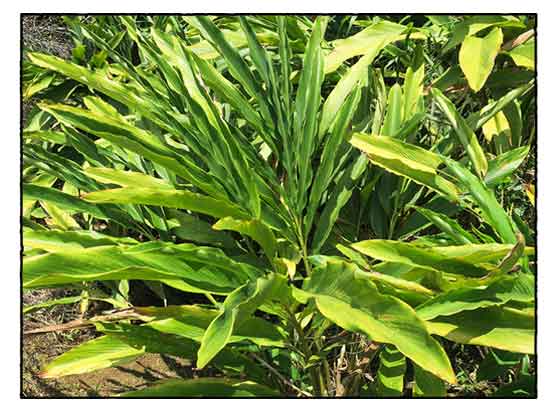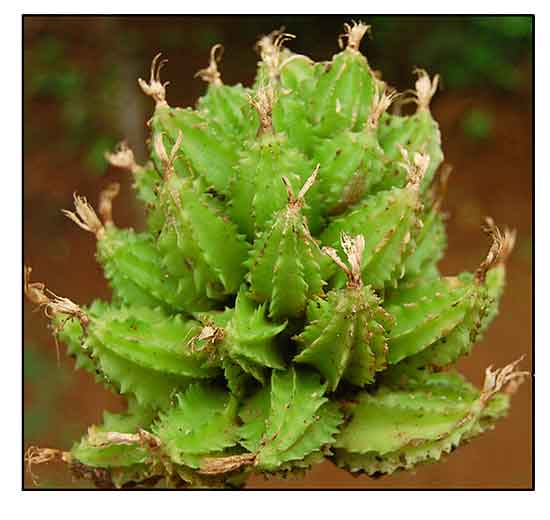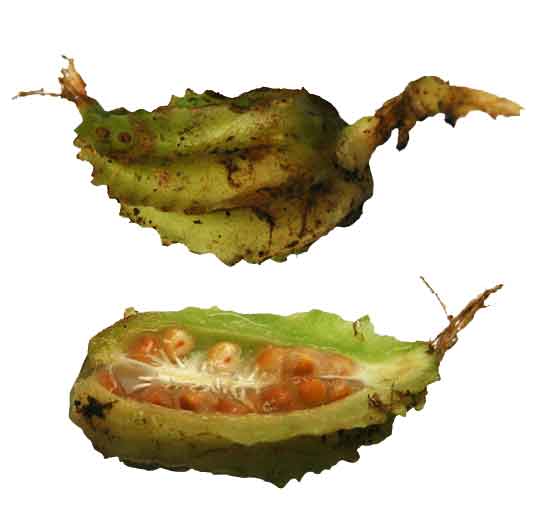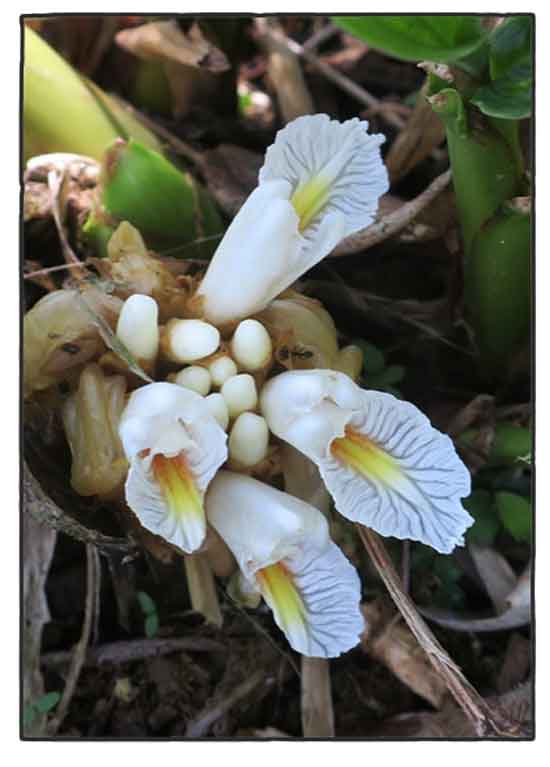 Gen info Gen info
- Amomum is a genus of plants remarkable for their pungency and aromatic properties. It includes several species of cardamom, especially black cardamom. Among ancient writers, the name amomum was ascribed to various odoriferous plants.
- Etymology: The genus name Amomum is Greek meaning "unblemished" or "faultless." The specific epithet dealbatum is Latin dealbatus, meaning "covered with a white powder" probably referring to the abaxially whitish leaf blades.
- Alternatively, amomum may be a latinization of the Greek amomon, a kind of Indian spice plant. Edmund Roberts noted on his 1834 trip to China of its use as a spice to "season sweet dishes."
(3)
- Amomum dealbatum Roxb. was reported for the first time in Bukidnon, Mindanao, in 2014. (2)
Botany
• Amomum maximum is a herbaceous plant. Ligule pale yellow-green, oblong, 2-cleft, 1.2-2 cm, sparsely white pubescent; petiole absent to 8 cm; leaf blade oblong or long elliptic, 30-90 × 10-20 cm, adaxially glabrous, abaxially white villous, base attenuate, decurrent, apex caudate. Spikes subglobose, ca. 5 cm in diam.; bracts brownish, 2-2.5 cm, pubescent, deciduous. Calyx pale purple spotted adaxially, ca. 2.3 cm, apex 3-toothed; teeth lanceolate, ca. 5 mm. Corolla tube slightly longer than calyx; lobes white, oblong. Labellum white, yellow on each side of midvein, red striate at base, ovate, ca. 3.5 cm, apex slightly revolute, entire. Filament short; anther linear, 1-1.2 cm; connective appendage yellowish, crescent-shaped, apex slightly revolute. Capsule purple-green, ovoid, 2.5--3 × 1.8--2.4 cm, 9-winged, white pubescent; pedicel 7-10 mm. (4)
 • Plants 1--3.5 m tall. Ligule orbicular, 2-cleft, 0.4--1.6 cm, rusty villous; petiole 0.5--3 cm; leaf blade adaxially bright green, abaxially whitish, oblong-lanceolate, 50--70 × 5.5--14 cm, adaxially glabrous, abaxially brownish pubescent, base cuneate, apex acuminate. Spikes subglobose, 3--5 cm in diam.; peduncle 2--8 cm; bracts reddish, ovate, ca. 2.5 cm. Calyx 3-lobed at apex; lobes 2-lobed. Corolla tube white, ca. 2.5 cm; lobes white, lanceolate, equaling tube. Lateral staminodes subulate, ca. 2 mm. Labellum white with yellow line along center and radiate, red veins, elliptic, ca. 2.5 cm, apex emarginate. Filament ca. 5 mm; anther ca. 2 mm; connective appendage elliptic, ca. 3 mm. Capsule purple-green, ellipsoid, 2.5--3 × 1--1.2 cm, with 9 crenulate-winged ribs, indehiscent; pedicel 1--2 cm. (Flora of China) • Plants 1--3.5 m tall. Ligule orbicular, 2-cleft, 0.4--1.6 cm, rusty villous; petiole 0.5--3 cm; leaf blade adaxially bright green, abaxially whitish, oblong-lanceolate, 50--70 × 5.5--14 cm, adaxially glabrous, abaxially brownish pubescent, base cuneate, apex acuminate. Spikes subglobose, 3--5 cm in diam.; peduncle 2--8 cm; bracts reddish, ovate, ca. 2.5 cm. Calyx 3-lobed at apex; lobes 2-lobed. Corolla tube white, ca. 2.5 cm; lobes white, lanceolate, equaling tube. Lateral staminodes subulate, ca. 2 mm. Labellum white with yellow line along center and radiate, red veins, elliptic, ca. 2.5 cm, apex emarginate. Filament ca. 5 mm; anther ca. 2 mm; connective appendage elliptic, ca. 3 mm. Capsule purple-green, ellipsoid, 2.5--3 × 1--1.2 cm, with 9 crenulate-winged ribs, indehiscent; pedicel 1--2 cm. (Flora of China)
Distribution
- Native to the Philippines.
- Also native to
Andaman Is., Assam, Bangladesh, China South-Central, China Southeast, East Himalaya, India, Jawa, Laos, Lesser Sunda Is., Myanmar, Nepal, New Guinea, Sri Lanka, Thailand, Tibet, Vietnam. (1)
 Constituents Constituents
- Hydrodistillation and GC-MS study of fruits for essential oil yielded main components of ß-pinene (23.39%), ß-caryophyllene (16.43%), α-pinene (7.55%), sylvestrene (6.61%), and c-cadubebe (4.19%). (see study below) (5)
- Study of ethyl acetate sub-fraction of ethanolic extract of rhizome yielded six labdane diterpenes: amoxanthin A (1). ottensinin (2), coronarin D (3), coronarin D methyl ether (4), isocoronarin D (5), and zerumin (6).
(see study below) (8)
- Hydrodistillation of different parts of A. maximum for essential oils identified major compounds of ß-pinene (20.4-40.8%),
α-pinene (6.8-15.0%), ß-elemene (2.5-12.8%), and ß-caryophyllene (2.3-10.3%). ß-phellandrene (11.6%) was present in the root oil. (9)
- Phytochemical screening of decoction and ethanolic extract of Amomum dealbatum leaves yielded flavonoids, alkaloids, and tannins. Triterpenoid was only detected on the extract. Neither extract nor decoction yielded saponins and steroids.
 Properties Properties
- Studies have suggested repellent, insecticidal, antioxidant, antidiabetic, anti-inflammatory, anthelmintic properties.
Parts used
Fruit, rhizome, flower.
Uses
Edibility
- Young fruits, young shoots, ad young inflorescences are eaten as vegetables.
-
Fruits are eaten raw, cooked, or candied; also used as spice.
- Fresh, sweet, juicy aril around ripe seeds considered a delicacy.
Folkloric
- In the Philippines, decoction of rhizomes used for treatment of cough; leaf decoction used for treatment of diarrhea. (12)
-
In India, rhizomes used to treat arthritis and abscesses. In Indonesia, decoction of leaves or rhizomes used as antiseptic by postpartum women to clean their puerperal area; also used to treat rheumatism and arthritis. (12)
-
In India, fruit used as masticatory and spice.
- Used for treatment of joint pain, diabetes, muscular rheumatism, abscesses; used as antiseptic.
Others
- Repellent: Used as repellent and insecticide.
Studies
• Amomum dealbatum / A New Record: Amomum dealbatum Roxb. was reported from the first time in Bukidnon, Mindanao in 2014. It was described morphologically using vegetative and reproductive organs with notes on plant ecology. Distinguishing features include bifid ligule, abaxially white villous leaf and ovate-oblong, nine-winged capsules. (2)
• Repellent / Insecticidal / Essential Oil / Fruit: Study evaluated the chemical constituents and insecticidal and repellent activities of essential oil from Amomum maximum fruits against two stored-product insects. The essential oil showed contact and fumigant toxicities against Tribolium castaneum adults (LD50 29.57 µg/adult and LC50 23.09 mg/L air, respectively. It showed contact toxicity against Liposcelis bostrychophila (LD50 67.46 µg/cm2). The EO showed 100% repellency at 78.63 nL/cm2 against T. castaneum and 84% repellency at 63.17 nL/cm2 against L. bostrychophila. Results suggest the fruit EO has potential for development as natural insecticide and repellent control of Tc and Lb. (see constituents above) (5)
• Anthelmintic: A crude extract of plant at varying doses of 1-50 mg/ml of phophate buffered saline showed dose dependent effect and motility and mortality of worm Raillietina echinobothrida. Surface topography of the worm revealed shrinkage, wrinkling of scolex and erosion of microtriches on the surface of proglottids. Results suggest anthelmintic activity against the cestode R. echinobothrida. (6)
• Anti-Inflammatory: Study evaluated the anti-inflammatory effects of methanol extract of Amomum maximum in murine macrophage RAW 264.7 cell line. The extract showed low cytotoxicity and potent anti-inflammatory activity by suppressing excessive nitric oxide (NO), with IC50 42.6 µg/mL. Activity may be modulation of inflammatory effect via the iNOS pathwaty. Results suggest potential for a natural anti-inflammatory drug. (7)
• Anti-Hyperglycemic / Rhizome: Study of ethanolic extract of A. maximum rhizome demonstrated hypoglycemic effects on both α-glucosidase assay in vitro and streptozotocin (STZ)-induced postprandial hyperglycemia in mice. Six labdane diterpenes were isolated from the ethyl acetate sub-fraction. Compounds 2 (ottensinin) and 6 (zerumin) exhibited significant inhibitory effect on
α-glucosidase and STZ-induced high postprandial blood glucose levels in mice. Molecular docking study showed compounds 2 and 6 could firmly bind to active sites of α-glucosidase, suggesting potential as anti-hyperglycemic agents. (see constituents above) (8)
• Antidiabetic / Flower: Study of ethyl acetate subfraction E3 significantly inhibited α-glucosidase (IC50 5.385 µg/mL). Quercetin-3-O-galactoside, myricetin, and gallic acid were isolated from flowers of A. dealbatum for the first time. Molecular docking revealed quercetin-3-O-galactoside to be the most potent
α-glucosidase inhibitor (binding energy -43.214 kcal/mol). E3 decreased blood glucose level to near-normal concentration (100.60 mg/dL) compared to diabetic control rats (527 mg/dL). Resullts suggest potential of ADF in treating diabetes. (10)
Availability
Wild-crafted.
|

![]()



 Gen info
Gen info
 Constituents
Constituents
